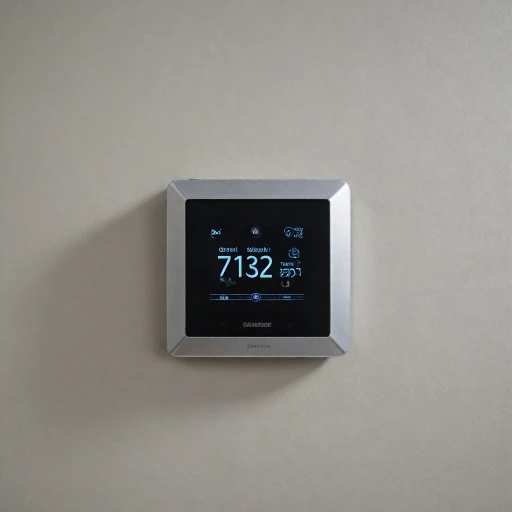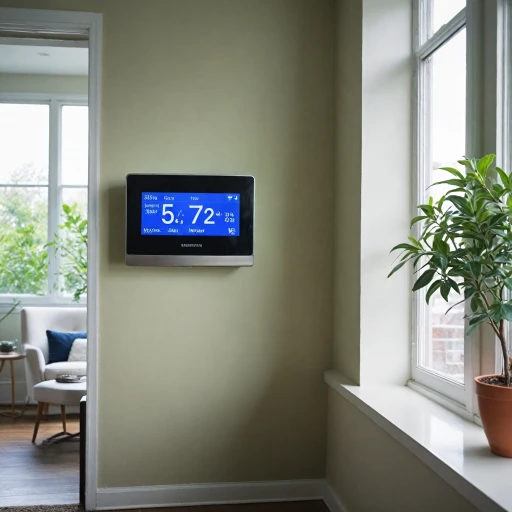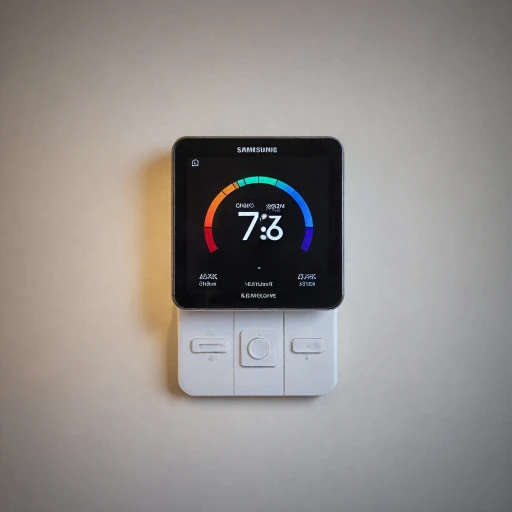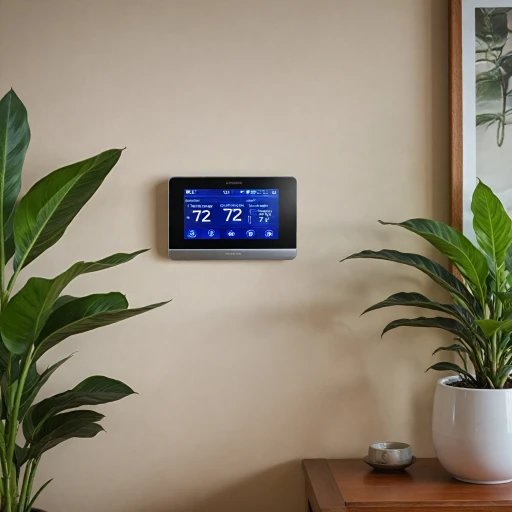What is a Wireless Thermostat and Receiver?
Exploring the Basics of Wireless Thermostats and their Receivers
Wireless thermostats have emerged as a pivotal component in modern homes, offering a seamless balance between comfort and energy efficiency. Unlike traditional thermostats that require intricate wiring, these smart devices communicate wirelessly with a receiver connected to your heating and cooling systems. This setup allows you to place your thermostat virtually anywhere in your home, without the hassle of complex installations. Wireless thermostats often come with smart technology, integrating with platforms like Alexa, Google Nest, and Apple HomeKit. This means you can control your home’s temperature using just your voice or through user-friendly apps on your smartphone. These features make it simpler to manage your home's heating and cooling, ensuring comfort while helping you save energy. Moreover, many smart thermostats incorporate sensors that detect changes in temperature, automatically adjusting to maintain an optimal climate. Brands such as Honeywell and Nest offer diverse models that cater to different needs and budgets, as reflected in their price ranges and stars reviews on retail platforms like Amazon. For those considering upgrading to a smart system, investing in a wireless programmable thermostat can be an effective way to enhance your home's energy efficiency. Not only do they serve as an advanced temperature control solution, but they also contribute to significant savings on your energy bills. To learn more about the specific benefits of wireless smart thermostats, explore our detailed guide here.Benefits of Using a Wireless Thermostat
The Power of Going Wireless: Enhancements and Conveniences
Integrating a wireless thermostat into your home can revolutionize the way you manage your heating and cooling, providing both convenience and efficiency. So, why exactly are these devices garnering high rating stars on major platforms like Amazon? To start with, a wireless thermostat offers the flexibility to control the home's temperature from virtually anywhere. Whether you're lounging on the couch or miles away, devices enabled with smart technology, such as the Google Nest or Honeywell thermostats, allow adjustments through user-friendly apps available on smartphones. Just a simple tap and your home environment is optimized to your liking. Consider the convenience of voice control as well. Many smart thermostats are compatible with virtual assistants such as Amazon Alexa or Google Home. This integration means you can adjust the thermostat settings with a simple voice command, adding an extra layer of ease, especially when your hands are full or while multitasking. Another key benefit lies in energy efficiency. Many programmable thermostats like the Nest thermostat are designed to understand your daily routine and optimize temperature settings to save energy, thus reducing your utility bills. These thermostats can also provide detailed energy reports, giving insights into energy consumption patterns and opportunities for savings. Moreover, wireless systems simplify the installation process. Since they don't require extensive wiring, homeowners can avoid invasive procedures that can disrupt daily life. Most products come with a detailed guide or app walkthrough for installation, making it accessible for most users. Lastly, the personalization factor should not be overlooked. Wireless programmable thermostats can be adjusted to suit various needs through customizable temperature schedules, which can be particularly beneficial in homes with diverse preferences. Explore further here to delve into how a wireless thermostat kit can further enhance your home setup. Whether you’re tech-savvy or just embarking on your smart home journey, the benefits of utilizing a wireless thermostat are clear. From saving energy to enhancing control over your home environment, it's a worthy investment backed by numerous stars reviews and customer satisfaction.Installation Process: What to Expect
Easy Steps for Setting Up Your New Smart Thermostat
Upgrading to a smart or wireless thermostat makes managing your home’s heating and cooling far more efficient. The installation process, while straightforward for many, can vary depending on the brand or model you choose, such as the Honeywell or Google Nest. For those non-DIY enthusiasts or if it's a complicated system, considering a professional installation might be worthwhile. Below are essential steps you should expect during the installation process.- Preparation and Compatibility Check: Before starting, verify your HVAC system's compatibility with the smart thermostat. This check is crucial as not every thermostat can work seamlessly with every system. Brands like Google Nest and others offer compatibility guides or online tools to assist in this step.
- Power Off Your HVAC System: Safety first! Make sure to switch off power to your HVAC system at the breaker to avoid electrical hazards during installation.
- Remove the Old Thermostat: Carefully detach your existing thermostat from the wall, noting how each wire is connected. Many smart thermostats come with handy labels to assist you in re-connecting wires correctly.
- Install the New Thermostat: Follow the manual included with your product to mount the device, whether it’s the popular Google Nest or another model. Securely attach the faceplate and connect the previously labeled wires according to the manufacturer’s instructions.
- Power On and Setup: Once the new thermostat is installed, power your HVAC system back on. Set up your thermostat by following the on-screen instructions or using an app like Amazon Alexa or Google Home. Many smart thermostats, such as programmable ones, offer a quick setup process.
Common Challenges and Troubleshooting Tips
Powering Through Common Setbacks
Even as smart technology advances, wireless thermostats can present certain challenges during and after installation. Awareness of these common issues ensures proactive management, maintaining the efficiency of your smart thermostat and enhancing your smart home experience.
Connectivity Interruptions
Wireless thermostats are heavily reliant on stable Wi-Fi connections for seamless operation. Connectivity interruptions can lead to disruptions in controlling temperature settings, especially if your thermostat is integrated with Amazon Alexa or Google Home. Ensure that your Wi-Fi network is robust and that your device is placed within a good range of the router, reducing the likelihood of delayed response times from the thermostat.
Software Glitches
Smart thermostats often receive updates to improve functionality. However, on occasion, these updates might cause the app or thermostat itself to glitch. Regularly check for new updates and ensure they are properly installed for optimal performance, particularly when using brands like Honeywell or Google Nest that frequently roll out software improvements.
Thermostat Calibration
Sometimes, thermostats might not accurately report room temperature due to improper calibration. This could affect energy efficiency and comfort levels. It's advisable to conduct regular sensor checks. Calibrating your wireless thermostat correctly can lead to significant savings in energy by optimizing heating and cooling cycles.
Compatibility Issues
If you're integrating your wireless thermostat with other smart devices like Apple HomeKit or Alexa, compatibility can emerge as an issue. Examining compatibility requirements before purchase can prevent such problems. Aim to purchase models highly rated for integration, which can be found in customer reviews.
Battery Life
Unless hardwired, most wireless thermostats function on batteries. Regularly checking and replacing them can prevent disruptions in service. Many users also monitor their thermostat’s battery status using an accompanying app, which is often provided by brands like Honeywell and Nest.
In conclusion, understanding and preparing for these common pitfalls can help maintain the reliability and convenience of your wireless programmable thermostat. This proactive approach is crucial for harnessing the full benefits of smart thermostat technologies in your modern home.
Integration with Smart Home Systems
Seamless Integration with Your Smart Home Ecosystem
Integrating a wireless thermostat into your smart home ecosystem is a game-changer for many homeowners. As homes evolve into smarter environments, having a smart thermostat can significantly enhance the synergy between various devices. Smart thermostats are designed to work with popular home automation systems. For instance, they can communicate effortlessly with Alexa Google and Apple HomeKit, providing you with voice control capabilities that make adjusting your home's temperature as simple as speaking. The integration with these platforms allows for central control of your heating and cooling systems, streamlining the experience for users who prefer using a single app or voice command. Moreover, products like the Nest thermostat and various Honeywell models are examples of programmable thermostats that can integrate into a broader smart home strategy. They offer energy-saving features which, when combined with the data from your smart home sensors, can optimize your home's efficiency. These sensors detect when you are home or away, allowing the thermostat to adjust temperatures automatically, leading to significant savings on your energy bill over time. Ensuring compatibility with existing systems, such as Google Nest, can simplify management via the Google app or Alexa app. This cross-platform functionality enables you to set your home’s temperature from virtually anywhere, even if you are miles away from home. It also means that you can receive updates and alerts directly on your smartphone. Before purchasing, compare models and brands to identify a thermostat that ranks highly in customer reviews and fits within your budget. Examining factors like delivery, price, and product rating stars on platforms like Amazon can be helpful. Prioritize thermometers that match your color preferences, such as thermostat white, for a seamless blend with your home decor. Finally, investing in a smart thermostat integration will not only enhance your home's comfort but also place you on a path towards more sustainable living by reducing energy consumption. When selecting, be mindful of programmable options and wireless functionality to enjoy a seamless and efficient smart home experience.Choosing the Right Wireless Thermostat for Your Home
Factors to Consider When Selecting Your Smart Thermostat
Choosing the right wireless thermostat for your home can significantly impact your comfort and energy savings. Here are some key factors to consider:
- Compatibility: Ensure the thermostat is compatible with your existing heating and cooling system. Some models, like the Nest Thermostat or Honeywell's range, offer broad compatibility.
- Smart Home Integration: If you use smart home systems like Amazon Alexa, Google Home, or Apple HomeKit, check if the thermostat integrates seamlessly. This allows for voice control and more streamlined operation.
- Energy Saving Features: Look for programmable thermostats that offer energy-saving modes or learning capabilities. Smart thermostats can adapt to your schedule, optimizing temperature settings to reduce energy consumption.
- Ease of Use: Consider the user interface and mobile app functionality. A good app should offer intuitive control and monitoring of your home's temperature from anywhere.
- Customer Reviews and Ratings: Check rating stars and customer reviews on platforms like Amazon to gauge user satisfaction and reliability. Products with high stars reviews are generally more reliable.
- Price and Value: Compare prices and features across models. While some thermostats might be more expensive, they could offer better long-term savings and convenience.
- Additional Features: Some models come with extra sensors or advanced features like geofencing, which adjusts the temperature based on your location.
By considering these factors, you can find a wireless programmable thermostat that meets your needs and enhances your home's comfort and efficiency.







